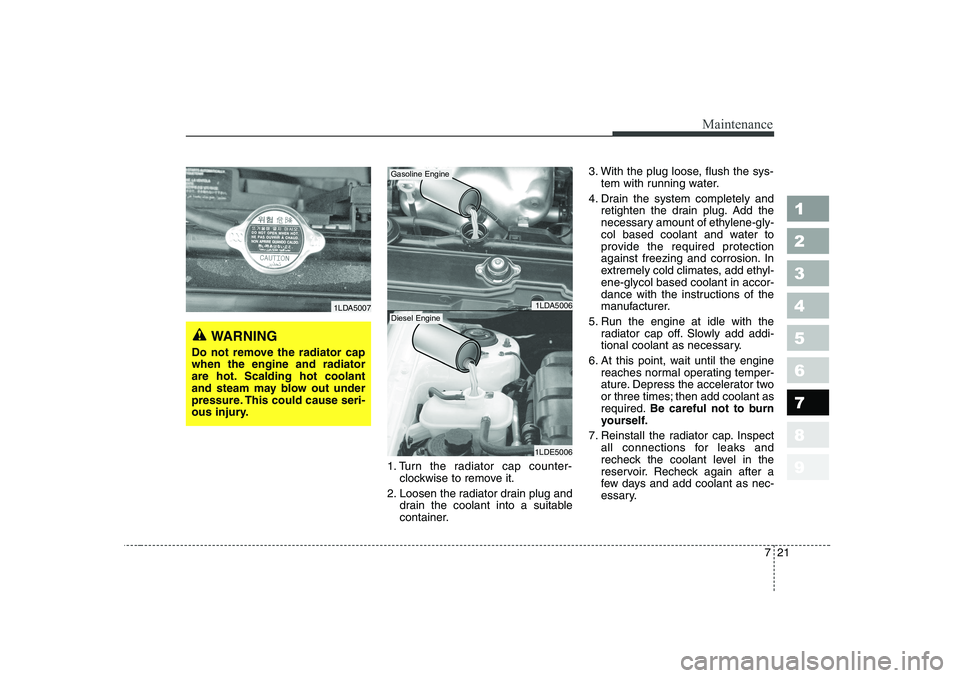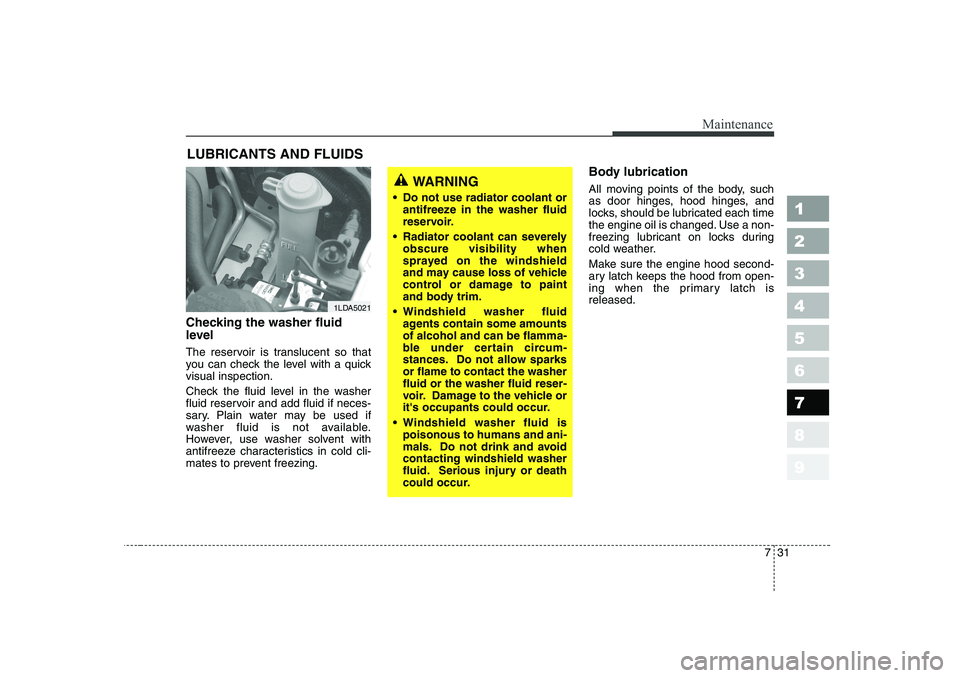Page 266 of 315

721
Maintenance
1 23456789
1. Turn the radiator cap counter-clockwise to remove it.
2. Loosen the radiator drain plug and drain the coolant into a suitable
container. 3. With the plug loose, flush the sys-
tem with running water.
4. Drain the system completely and retighten the drain plug. Add the
necessary amount of ethylene-gly-
col based coolant and water to
provide the required protection
against freezing and corrosion. In
extremely cold climates, add ethyl-ene-glycol based coolant in accor-
dance with the instructions of the
manufacturer.
5. Run the engine at idle with the radiator cap off. Slowly add addi-
tional coolant as necessary.
6. At this point, wait until the engine reaches normal operating temper-
ature. Depress the accelerator two
or three times; then add coolant asrequired. Be careful not to burn
yourself.
7. Reinstall the radiator cap. Inspect all connections for leaks and
recheck the coolant level in the
reservoir. Recheck again after a
few days and add coolant as nec-
essary.
1LDA5006
1LDE5006
1LDA5007
WARNING
Do not remove the radiator cap when the engine and radiator
are hot. Scalding hot coolant
and steam may blow out under
pressure. This could cause seri-
ous injury.
Gasoline Engine
Diesel Engine
Page 276 of 315

731
Maintenance
1 23456789
LUBRICANTS AND FLUIDS
Checking the washer fluid
level
The reservoir is translucent so that
you can check the level with a quickvisual inspection.
Check the fluid level in the washer
fluid reservoir and add fluid if neces-
sary. Plain water may be used if
washer fluid is not available.
However, use washer solvent with
antifreeze characteristics in cold cli-
mates to prevent freezing. Body lubrication
All moving points of the body, such
as door hinges, hood hinges, and
locks, should be lubricated each time
the engine oil is changed. Use a non-
freezing lubricant on locks during
cold weather.
Make sure the engine hood second-
ary latch keeps the hood from open-
ing when the primary latch isreleased.
1LDA5021
WARNING
Do not use radiator coolant or antifreeze in the washer fluid
reservoir.
Radiator coolant can severely obscure visibility when
sprayed on the windshield
and may cause loss of vehicle
control or damage to paint
and body trim.
Windshield washer fluid agents contain some amountsof alcohol and can be flamma-
ble under certain circum-
stances. Do not allow sparksor flame to contact the washerfluid or the washer fluid reser-
voir. Damage to the vehicle or
it's occupants could occur.
Windshield washer fluid is poisonous to humans and ani-
mals. Do not drink and avoidcontacting windshield washer
fluid. Serious injury or death
could occur.
Page 310 of 315
83
1 23456789
Specifications
*¹Refer to the recommended SAE viscosity numbers on the page 7-57.
Lubricant Volume Classification
3.3 l (3.5 US qt.) API Service SJ, SL or above,
4.0 l (4.2 US qt.) ILSAC GF-3 or above
5.3 l (5.6 US qt.) API Service CH-4 or above,
ACEA B4 or above
API Service CF-4 or above,
5.9 l (6.2 US qt.)
ACEA B4 or above
2.15 l (2.27 US qt.)
2.0 l (2.11 US qt.) API Service GL-4
2.10 l (2.22 US qt.) SAE 75W-85 (fill for-life)
Automatic transaxle fluid 6.1
l (6.45 US qt.) DIAMOND ATF SP-III,
7.8 l (8.2 US qt.) SK ATF SP-III
Power steering 0.8 l (0.8 US qt.) PSF-III
Coolant 8.14
l (8.6 US qt.) Ethylene glycol base for
6.97 l (7.37 US qt.) aluminum radiator
Brake/Clutch fluid 0.7~0.8
l
FMVSS116 DOT-3 or DOT-4
(0.7~0.8 US qt.)
Fuel 55 l (14.5 US gal) -
Engine oil *1
(with filter change)
Manual transaxle fluid Gasoline
Engine
Gasoline Engine
Diesel
Engine Diesel
Engine 1.6L
2.0L
2.0L
1.5L/1.6L
2.0L
1.5L/1.6L
2.0L
1.6L
1.6L
1.5L
Capacities